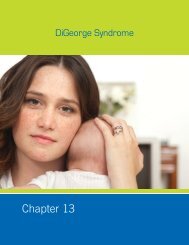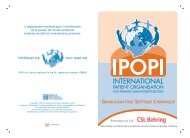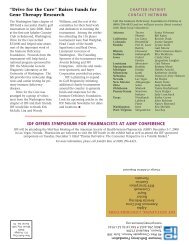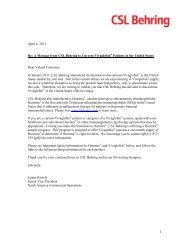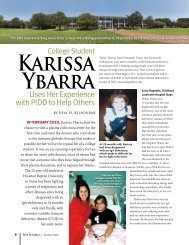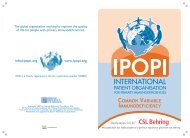IDF Patient & Family Handbook for Primary Immunodeficiency ... - IDFA
IDF Patient & Family Handbook for Primary Immunodeficiency ... - IDFA
IDF Patient & Family Handbook for Primary Immunodeficiency ... - IDFA
Create successful ePaper yourself
Turn your PDF publications into a flip-book with our unique Google optimized e-Paper software.
Specific Medical Therapy 97<br />
Hematopoietic Stem Cell Transplantation continued<br />
The four loci in each haplotype are clustered together<br />
on each of the 6th chromosomes (see Figure 1<br />
below). The ways that parents could pass them<br />
on to their children are also shown in the diagram.<br />
In almost all cases, the four genes making up the<br />
haplotype on one chromosome stay together when<br />
the paired chromosomes are separated and one<br />
member of each pair goes into one individual egg or<br />
sperm cell. Like any other genetic characteristic, the<br />
choice of which of the two number 6 chromosomes<br />
goes into any given sperm or egg cell occurs in a<br />
random fashion. Whichever one of each parent’s<br />
chromosomes is passed on to a child determines<br />
each of the two haplotypes the child will have.<br />
As with any other genetic characteristic, each<br />
parent passes on only one chromosome and only<br />
one set of transplantation genes (haplotype) to each<br />
child. There are only four possible combinations<br />
of haplotypes in the children. Each of the four<br />
combinations is represented in Figure 1.<br />
In the usual situation, a brother or sister of the patient<br />
is selected as the donor. Each sibling has a 25%<br />
chance of having the same transplantation genes<br />
and being a perfect match <strong>for</strong> the patient since there<br />
are only four possible combinations of genes. Due to<br />
the laws of probability and the fact that most families<br />
have limited numbers of children, fewer than 25% of<br />
patients have a sibling which is a “match.” There has<br />
been a major ef<strong>for</strong>t to develop alternative methods<br />
<strong>for</strong> giving transplants to patients who do not have a<br />
matched donor in their own family.<br />
CHAPTER 18; FIGURE 1<br />
Selection of the Donor<br />
Matched Unrelated Donors<br />
If an HLA identical matched sibling donor is not<br />
available, one alternative is to try to find a suitable<br />
“matched” donor through one of the worldwide<br />
computer-based registries of individuals who<br />
have volunteered to serve as bone marrow<br />
donors. The National Marrow Donor Program<br />
in the United States has listings of hundreds of<br />
thousands of individuals who have provided a<br />
blood sample to have their HLA type measured.<br />
Successful transplants <strong>for</strong> patients with a primary<br />
immunodeficiency using donors found through<br />
this and other registries have saved the lives of<br />
many patients over the past 20 years with results<br />
using a fully matched unrelated donor (MUD<br />
donor) now approaching the success rate <strong>for</strong><br />
transplants using sibling matches. There have<br />
also been many patients successfully transplanted<br />
using donors that were not fully matched. The<br />
success rate <strong>for</strong> such transplants has not been<br />
as high as with those full matches and diminishes<br />
with the greater the degree of mismatch between<br />
donor and patient. With mismatched transplants,<br />
other measures must be added to the transplant<br />
procedure in ef<strong>for</strong>t to protect the patient from<br />
graft versus host disease or GvHD that may occur<br />
when the T-cells in the graft recognize the new<br />
host as <strong>for</strong>eign and begin to attack.<br />
Another source of HSC that may be used<br />
<strong>for</strong> transplantation in patients with primary<br />
immunodeficiency is umbilical cord blood. In the<br />
growing fetus, the HSC frequently leaves the<br />
marrow and are found circulating in high numbers<br />
in the blood. At the time of birth, the placenta is<br />
recovered, the blood that is remaining is removed<br />
and the HSC isolated and banked. These cord<br />
blood HSC may then be HLA typed and used<br />
<strong>for</strong> transplantation. Since cord blood contains<br />
fewer mature T-lymphocytes than the marrow<br />
or blood of adult donors, sometimes cord blood<br />
transplants have been successful even though<br />
the degree of match between donor and patient<br />
was not very good. A limitation of cord blood HSC<br />
transplantation is if only a small amount of cord<br />
blood is obtained, there may not be a sufficient<br />
number of HSC to treat a larger child or adult.<br />
T-cell Depletion<br />
Another alternative approach <strong>for</strong> the transplantation<br />
of a patient who does not have a matched sibling<br />
donor is to remove the mature T-lymphocytes<br />
from the stem cells be<strong>for</strong>e infusing them into the<br />
patient. In this way, the infused cells are less able







